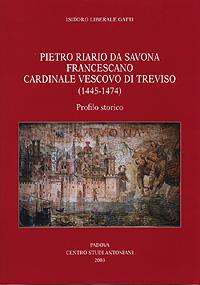Pietro Riario da Savona, francescano cardinale vescovo di Treviso (1445-1474). Profilo storico

Nota: L'acquisto on-line verrà gestito attraverso il sito LIBRERIA DEL SANTO. Il volume può essere richiesto anche direttamente al Centro Studi Antoniani inviando una email a info@centrostudiantoniani.it
Il volume presenta una sistematica biografia del cardinale Pietro Riario, nipote di Sisto IV, anch'egli frate Minore Conventuale, che visse una breve ma intensa vita dal 1445 al 1474. Dopo un esame di diversi documenti sono state rintracciate le origini dei numerosi epigrammi accusatori che furono pubblicati contro di lui. Viene dunque tracciato un quadro degli aspetti peculiari del suo carattere, delineandone storicamente luci e ombre in modo da ottenerne un profilo storico vero e obiettivo. Il Riario divenne cardinale in giovanissima età, ebbe enormi (forse troppo) responsabilità politiche (fu ministro degli Affari Esteri). Fu uomo intelligente, colto, abile diplomatico ma innamorato di uno stile di vita lussuoso e prodigo che lo fece conoscere per la sua ricchezza e per il suo mecenatismo culturale e artistico. La sua ambizione era quella di elevare la corte papale, destinata alla grandezza da Dio, su tutte le corti europee, emulando i Medici di Firenze e gli Estensi di Ferrara, grazie a ricchezza, straordinaria potenza, generosa ospitalità verso reali, letterati; sfortunatamente tutto ciò fu però visto anche come uno sperpero esagerato. Queste manifestazioni furono manipolate dai suoi nemici in modo diabolico e insistente tanto da dipingerlo con un numero infinito di ridicole e volgari rappresentazioni. Le sue iniziative furono distorte e trasformate in versi o in prosa da cronisti e epigrammisti prevenuti o male informati. Essi ritrassero il Riario come un cocktail di ignoranza, presunzione e immeritata ricchezza; non fornirono però mai delle prove ma solo dei "sentito dire", cioè definizioni prive di serietà e oggettività scientifica. L'evidenza storica, e questa è la ferma conclusione dell'autore, rivela invece che queste intemperanze e oscenità non corrisposero mai in alcun modo alla realtà dei fatti.
The author presents a systematic biography of cardinal Pietro Riario for the first time since the cardinal's death. The cardinal was a Franciscan Conventual and nephew of Pope Sixtus IV. He lived a brief but intense life from 1445 to 1474. After an examination of all the documents present, the author retraces the origins of the numerous accusatory epigrams published against him. In the attempt to present a synthetic picture of the central aspects of Riario's moral character, with its historic light and dark sides, and in the author's desire and belief in having reached a true and factual picture, we could conclude as follows: Riario was a cardinal who was (too) young, with political responsibilities which were (too) big for him (Minister of Foreign Affairs), he was intelligent, learned, able, with diplomatic skills, but in love with a magnificent and lavish living-style which brought him to the public's attention in regard to the wealth at his disposal and for his patronage of culture and art. His ambitious aspiration was to elevate the Papal court, destined to greatness by God, above all the European courts. He believed this could be achieved, almost as in emulation of the Medici of Florence or the Estensi of Ferrara, by wealth, extraordinary pomp, the generous and magnificent hospitality offered to royals, men of letters. Unfortunately, these initiatives were manipulated by many of his enemies in a way that was evil, insistent and presented to the public as an infinite number of ridiculous and vulgar exhibitions. These initiatives were therefore distorted and then retold in verse or prose by chroniclers and epigrammists who were prejudiced or badly informed. They portrayed Riario as a cocktail of ignorance, presumption and undeserved wealth. Never, however, did they furnish proof but always and only the "they say", in other words, documentary evidence void of seriousness and scientific objectivity. However, and this is the conclusion, historical evidence reveals that this foolish behaviour, crapulence and obscenity was non-existent and did not in any way correspond to the truth.
Archivo Iberico-Americano, 64, 2004
Archivum Franciscanum Historicum, fasc 3-4, 2004
Deutsches Archiv fur Erforschung des Mittelalters Bd. 62,1, 407-408

